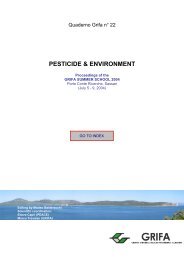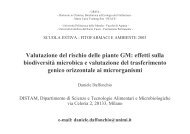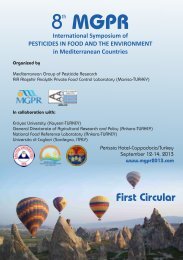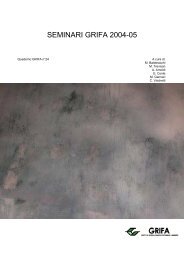International Congress BIOLOGICAL PRODUCTS - Gruppo di ...
International Congress BIOLOGICAL PRODUCTS - Gruppo di ...
International Congress BIOLOGICAL PRODUCTS - Gruppo di ...
You also want an ePaper? Increase the reach of your titles
YUMPU automatically turns print PDFs into web optimized ePapers that Google loves.
18<br />
INFLUENCE OF DIFFERENT TREATMENTS ON Cd (II), Cu (II), Pb (II) AND Zn (II) CONTENT IN<br />
SICILIAN OLIVE OILS<br />
La Pera Lara, Lo Turco Vincenzo, Lo Curto Simona, Mavrogeni Ekaterini, Dugo Giacomo<br />
Dipartimento <strong>di</strong> Chmica Organica e Biologica Università <strong>di</strong> Messina Salita Sperone, 31, 90166 S. Agata-<br />
Messina<br />
Metals can be found in fatty food as e<strong>di</strong>ble oils that are often subjected to refining, bleaching, and<br />
deodorization, during which they inevitably come in contact to metallic surfaces (1). Trace levels of some metal<br />
ions like Cu (II) could catalyse the oxidation reaction of fatty acid chains, with conseguent a deleterious effect on<br />
oil flavor and shelf-life of oils (2).<br />
Metals contamination of olive oil could be due to their presence in the soil, water and, particularly for<br />
lead, in the air (3). Many stu<strong>di</strong>es have been carried out in which the presence of trace metals in olive oils was<br />
correlated to agronomical techniques, harvesting methods, oil extraction and packaging procedures (4, 5). The<br />
purpose of this paper was to explore the correlation between the pesticide treatments occurred in olive growing<br />
and the content of metals found in oils.<br />
The analytical techniques frequently used for the subsequent determinations are emission and absorption<br />
spectrophotometric techniques as well as electroanalytical techniques (2,6).<br />
In this paper derivative potentiometric stripping analysis (dPSA) was used to determine copper (II), lead<br />
(II), cadmium (II) and zinc (II), in samples of virgin olive oils from Sicily (7-9).<br />
MATERIALS AND METHODS<br />
Samples<br />
Seven olive oils samples belonging to Nocellara del Belice variety, produced in the crop year 2000 -2001<br />
from plants grown up on sandy soils in the zone of Valle del Belice (Trapani), were stu<strong>di</strong>ed. Each of these<br />
samples was originated from olive grove subjected to <strong>di</strong>fferent pesticides treatments as <strong>di</strong>methoate/fenthion,<br />
<strong>di</strong>methoate, copper oxy-chlorine/<strong>di</strong>methoate, copper oxy-chlorine/fenthion; biological treatments as copper oxychlorine<br />
and biological fight and no treatment.<br />
Oil samples were stored in dark glassy bottles at 4°C for the time of analysis.<br />
Chemicals<br />
Ultra pure hydrochloric acid (34-37%), Hg (II) (1000 µgmL -1 , 1M in hydrochloric acid) and Cd (II), Cu<br />
(II), Pb (II), Zn (II), Ga (III) and Pd (II) (1000 µg mL -1 , 0.5 N in nitric acid) standard solutions were purchased<br />
by Panreac Quimica (Barcelona, Spain). The extracts are filtrated on a carbon column Supelclean ENVI-Carb<br />
SPE (0.5 g, 6 mL), purchased by Supelco (Bellefonte, PA, USA).<br />
Apparatus<br />
Determinations were carried out using a PSA ION 3 potentiometric stripping analyzer (Steroglass, S.<br />
Martino in Campo, Perugia, Italy), connected to an IBM-compatible personal computer. The analyzer operated<br />
under the control of the NEOTES software package (Steroglass).<br />
Electrode Preparation (plating) and potentiometric determination<br />
Working electrode was a glassy carbon electrode coated with a Hg film, the reference one was an<br />
Ag/AgCl electrode; the counter was a Pt electrode. The plating of the working electrode was effected putting in<br />
the electrochemical cell a 20 mL volume of a 1000 µgmL -1 Hg standard solution and carrying out the<br />
electrolysis, at –950 mV against the reference electrode, for 1 min.<br />
The determination of Cd, Cu and Pb in oily extract was executed at pH 0.5, putting in the electrochemical<br />
cell a 3 mL volume of elute, a 17 mL volume of ultra pure H2O and a 1 mL volume of Hg (II) standard solution<br />
as oxidant agent. The determination of Zn was executed at pH 1.8, putting in the electrochemical cell a 1 mL<br />
volume of elute, 18.5 mL of ultra pure H2O and 0.5 mL of Hg (II) standard solution as oxidant agent. The<br />
quantitatve analysis was carried out by the multiple standard ad<strong>di</strong>tion method. Metals determination was<br />
managed under analytical con<strong>di</strong>tions described in table 1.<br />
RESULTS AND DISUSSION<br />
Method<br />
The repeatability of the method was attested at 86.4 % for cadmium, at 94.9% for copper, at 99.0% for<br />
lead and at 98.9% for zinc. Recoveries were carried out by spiking a sample of olive oil at <strong>di</strong>fferent levels.<br />
PDF creato con FinePrint pdfFactory versione <strong>di</strong>mostrativa http://www.secom.re.it/fineprint<br />
94








